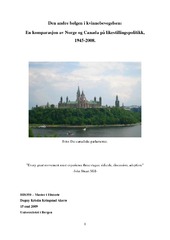| dc.description.abstract | The Second Wave in the Women's Movement - A Comparative Study of Norway and Canada on Gender Equality in Politics. Written by: Dagny Kristin Kringstad Akerø This thesis aims to compare Norway and Canada on politics regarding gender equity and gender equality. In 1986 Norway received international attention when the former Prime Minister Gro Harlem Brundtland, the first female PM in Norway, formed the world's first female government". Women made up an impressive 44 precent of that government. Since the 1970s Norway has been a global leader in gender equality. When it comes to women in politics, why is Canada (20% of government representation by females) lacking behind compared to Norway (40% of government representatives being female)? There are several factors that might have played a role in this outcome. Should women and men be treated equally without regarding the differences, or should they be treated different to become more equal? Canada has followed the first, while Norway has followed the second and more radical approach. The paper begins with an introduction of the topic and important terms. The way country defines terms such as gender, gender equality, politics, state, and citizenships helps explain why Norway and Canada might have chosen a certain direction or a specific public policy. Next, the paper sets out to give a short introduction of comparative method. A comparative approach provides insight into both the foreign and the familiar countries in the study. The Norwegian Equality Law" (1978) not only protects women against discrimination based on gender. It also allows different treatment if it sets out to increase gender equality. This is called positive discrimination". Since historically women, as a gender group, have faced more obstacles than men, this type of discrimination is intended to provide them with advantages that will help to level the playing field. An example of positive discrimination is gender quotas. The Canadian Charter of Rights and Freedoms (1982) and its gender clauses, section 15 and 28 (1985), protects women and men against discrimination based on gender. These rights are embedded in the Canadian constitution, which is not the case in Norway. Both the Equality Law and the Charter were introduced during the Second Wave of the women's movement. They have similar processes and they both aim to protect women (gender) against any form of discrimination, but the results have not been the same for women in politics in the two countries. | en_US |
